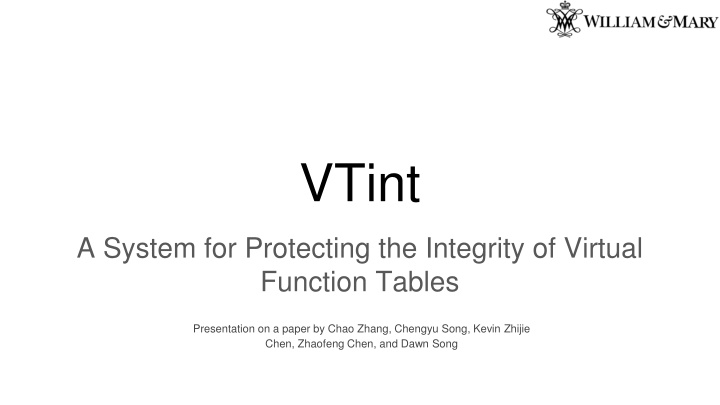
Protecting Virtual Function Tables Integrity: VTint System Overview
Explore the VTint system designed to safeguard virtual function tables from memory corruption bugs and attacks by protecting virtual function table pointers. Learn about the background, virtual function tables, research problem, and threat model assumptions in this presentation by Chao Zhang, Chengyu Song, Kevin Zhijie Chen, Zhaofeng Chen, and Dawn Song.
Download Presentation

Please find below an Image/Link to download the presentation.
The content on the website is provided AS IS for your information and personal use only. It may not be sold, licensed, or shared on other websites without obtaining consent from the author. If you encounter any issues during the download, it is possible that the publisher has removed the file from their server.
You are allowed to download the files provided on this website for personal or commercial use, subject to the condition that they are used lawfully. All files are the property of their respective owners.
The content on the website is provided AS IS for your information and personal use only. It may not be sold, licensed, or shared on other websites without obtaining consent from the author.
E N D
Presentation Transcript
VTint A System for Protecting the Integrity of Virtual Function Tables Presentation on a paper by Chao Zhang, Chengyu Song, Kevin Zhijie Chen, Zhaofeng Chen, and Dawn Song
Background: Attackers Motivation - Memory corruption bugs are a classic vulnerability - Exploitation allows attackers to access data, code - This access can be used to alter program behavior, state, and control flow - Buffer overflow attacks, for example
Background: Attackers Motivation - Popular targets of attacks are pointers to code; control data - There has been a lot of work in preventing attacks on control data - StackGuard - SafeSEH - DEP - ASLR
Background: Attackers Motivation - Attackers turning to other targets in light of work protecting traditional control data targets - And what makes a better target but yet more pointers? - Pointers to control data: Virtual Function Table Pointers
Background: Virtual Function Tables - Virtual functions are used to support polymorphism and dynamic dispatch in languages like C++ - Inheriting classes can overwrite these functions - vfptr: hidden field of classes with virtual functions - Points to the Virtual Function Table (vtable) for that object - This table contains function pointers that point to the appropriate (most- derived) versions of the functions for that object
Research Problem - How can we protect the integrity of virtual function tables and virtual function table pointers and make them resistant to attacks?
Threat Model Assumptions about attackers: 1)Can read arbitrary readable memory 2)Can write to any writable memory 3)Cannot directly read or write registers 4)Can use multiple threads
Threat Model Assumptions about defense: 1)Things like ASLR and DEP are in use 2)Applications won t let attackers change memory protection 3)Control-flow transfers aside from virtual function calls are protected 4)Binaries are not obfuscated 5)Programs follow traditional calling conventions
Threat Model Types of Vtable Hijacking Attacks: 1)Vtable corruption - corrupt a vtable s contents 2)Vtable injection - create fake vtables and point vfptr to them 3)Vtable reuse - overwrite vfptr to point to other code
Threat Model - Commonly exploited vulnerabilities: buffer overflow, type confusion, use-after- free - Use-after-free is the most major threat - Accounts for 80% of attacks against chrome, 50% against Windows 7 - Most of these attacks are vtable injection
Existing Solutions - VTGuard - SafeDispatch - DieHard
VTGuard - Used in IE - On a virtual function dispatch, checks for a secret cookie that was inserted into each vtable
SafeDispatch - Compiler-based - Analyzes classes to determine valid vtables and virtual functions - Inserts security checks before dispatch - Two types of checks: method and vtable
DieHard - Custom memory allocator randomizes and separates memory allocation - Probabilistic protection against vulnerabilities (ie. use-after-free) - Can protect against some cases of vtable and vfptr overwrites
Limitations of Existing Solutions - Don t cover all vtable hijacking possibilities - High levels of overhead (SD, DieHard) - Vulnerability to information leakage (VTGuard) - Lack of ability to protect binary executables
VTint Design - Consists of a security policy and a system to deploy this policy via binary rewriting - System takes in a PE executable and outputs a hardened PE - System is comprised of 3 major parts: - PEParser - BitCover - VRewriter
VTint Security Policy - Takes a cue from DEP - Enforces all vtables to be in read-only memory - This mitigates vtable injection and vtable corruption - Also takes cue from VTGuard - Gives vtables a special ID, checked on dispatch - Limits vtable reuse to legitimate vtables
VTint General Workflow - Parse PE executable - Identify candidate vtables and virtual function dispatch - Disassemble PE executable - Verify actual vtables and function calls from candidates - Instrument vtables with IDs, make sure all vtables read-only - Now you have a hardened PE
VTint Step 1: PEParser - Parses the binary (surprise!) - Builds the set of candidate vtables and function entries - But how with just the binary? - Relocation table - Relocation entries (addresses) that point to arrays (vfptr) with other relocation entries (function pointers) are candidate vtables - Export table - Entries in export table + other relocation entries = candidate function entries
VTint Step 2: BitCover - Takes the candidate function entries and vtables from PEParser - Uses candidate functions to start recursive disassembling - Once binary is disassembled, BitCover is responsible for: - Identifying actual vtables - Identifying actual virtual function calls
VTint Step 2a: BitCover Identifies vtables - There s actually a step necessary before this can really happen - Must identify constructor functions - Consider assignments involving candidate vtables - Analyze target memory to identify register as candidate object pointer - Locate source of this register, and considering calling conventions, may mark as a constructor function
VTint Step 2a: BitCover Identifies vtables - With identified construction functions, can identify vtables - The process for each candidate vtable: - Examine all relocation entries to find references to the pointer - For each reference, examine data-flow - Reference is a vtable assignment if: pointer assigned to memory before accesses to it - If all references are vtable assignments, then we have an actual vtable
VTint Step 2b: BitCover identifies virtual function calls - Identify candidate virtual function calls via notion of definition point - For all call/jump instructions: - Find definition point of target function - If found and another register used, locate definition point of that register (candidate vfptr) - If found and another register used (candidate this), then candidate virtual function call found - Passing of this pointer to callee must then match one of four patterns
VTint Step 3: VRewriter, well, rewrites - Continuing trend of straightforward naming - 3 parts: - Move vtables to read-only - Give vtables special ID - Place security checks before virtual function calls
VTint Step 3a: Moving vtables - Create read-only section named vtsec - Copy all identified vtables to this section - Copy some extra bytes to make sure to get all metadata
VTint Step 3b: vtable IDs - Similar idea to VTGuard, differing implementation - VTGuard adds ID to end of vtable - Can t do this with the binary - Instead, place an ID at beginning of each page in vtsec - Can t forge a read-only page with these ID s, nullifying information leakage
VTint Step 3c: Security checks before function calls - Add in check of vtable s ID - Add in check of vtable s writability - OS API function (IsBadWritePtr) or custom function making use of SEH - Second option is one used by VTint
VTint Modularity/Compatibility - What if all modules of a program can t be hardened or weren t hardened? - Security check may fail on a vtable without an ID - Fail-safe check to address this issue - Check for vtsec; if not found, it s an unhardened PE - In this case, an ID mismatch won t report an attack - Will still check for read-only
Evaluation of VTint - Prototype written in C++ for x86 PE on Windows - Experiments done with SPEC2000, SPEC2006 benchmarks, as well as Firefox, Chrome, IE6, and IE8 - Results include: - Statistics regarding vtables - Runtime overhead on SPEC benchmarks - Runtime overhead on real browser and associated benchmarks - Detailed performance analysis
Evaluation of VTint - Mean value of SPEC benchmark overhead was 0.37%
Evaluation of VTint - Mean value of Firefox overhead was 1.84%
Evaluation of VTint - Mean value of Chrome overhead was 1.37%
Evaluation of VTint - Tested 6 vtable injection attacks, 3 against IE and 3 against Firefox - Successfully protected against all 6 attacks
Limitations - VTint prototype was only designed for Windows platforms and more specifically Windows PE executables - Checking for writable memory imposes the most overhead, while having the least effect (most vtables are legitimate and read-only) - Has to be combined with VTGuard to defeat all vtable reuse attacks - Incompatible with unhardened modules having writable vtables
Criticisms - Paper mentions great degree of attacks against Chrome but tests none due to lack of public availability - This could make claim that VTint defeats ALL vtable injection attacks somewhat dubious - Claims security policy is easy to enforce but implementation seems fairly complicated - Doesn t gracefully handle failed security checks; blocks or terminates application - Some threat model assumptions seem rather strong What if the binary had been compromised and VTint verifies malicious
3 Questions - What comprises the candidate vtables and function entries? - What does VTint have to do before it can verify actual vtables? - What s the difference between vtable injection and a vtable corruption attack?




